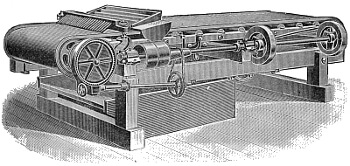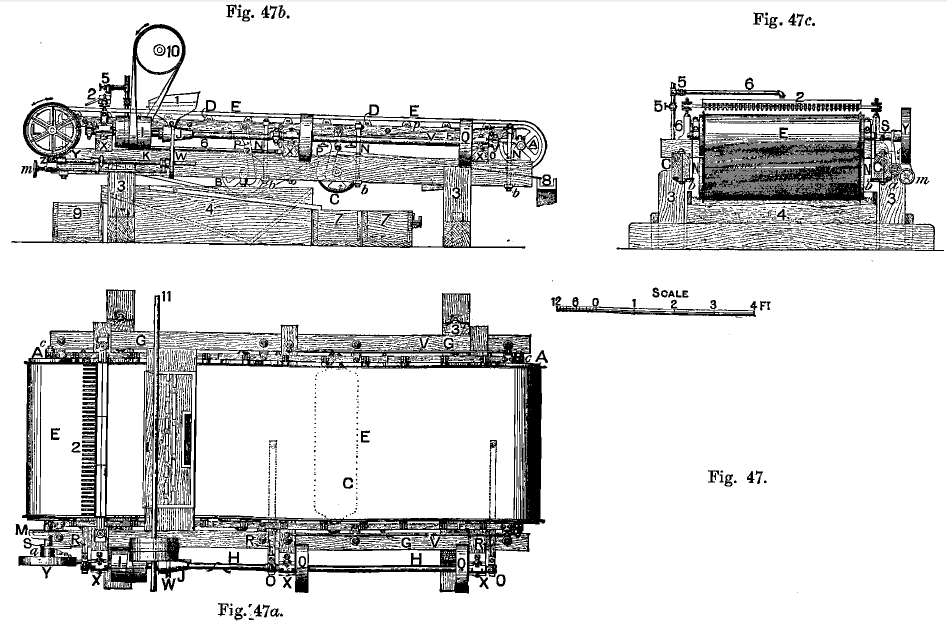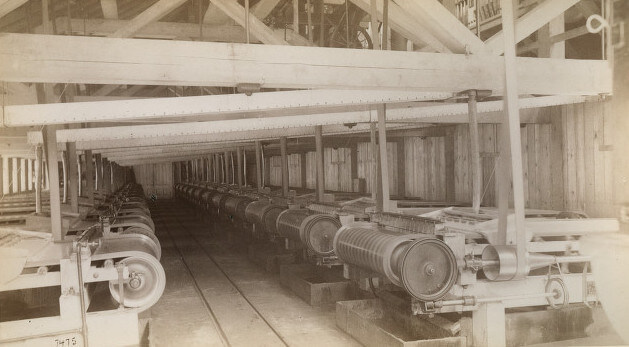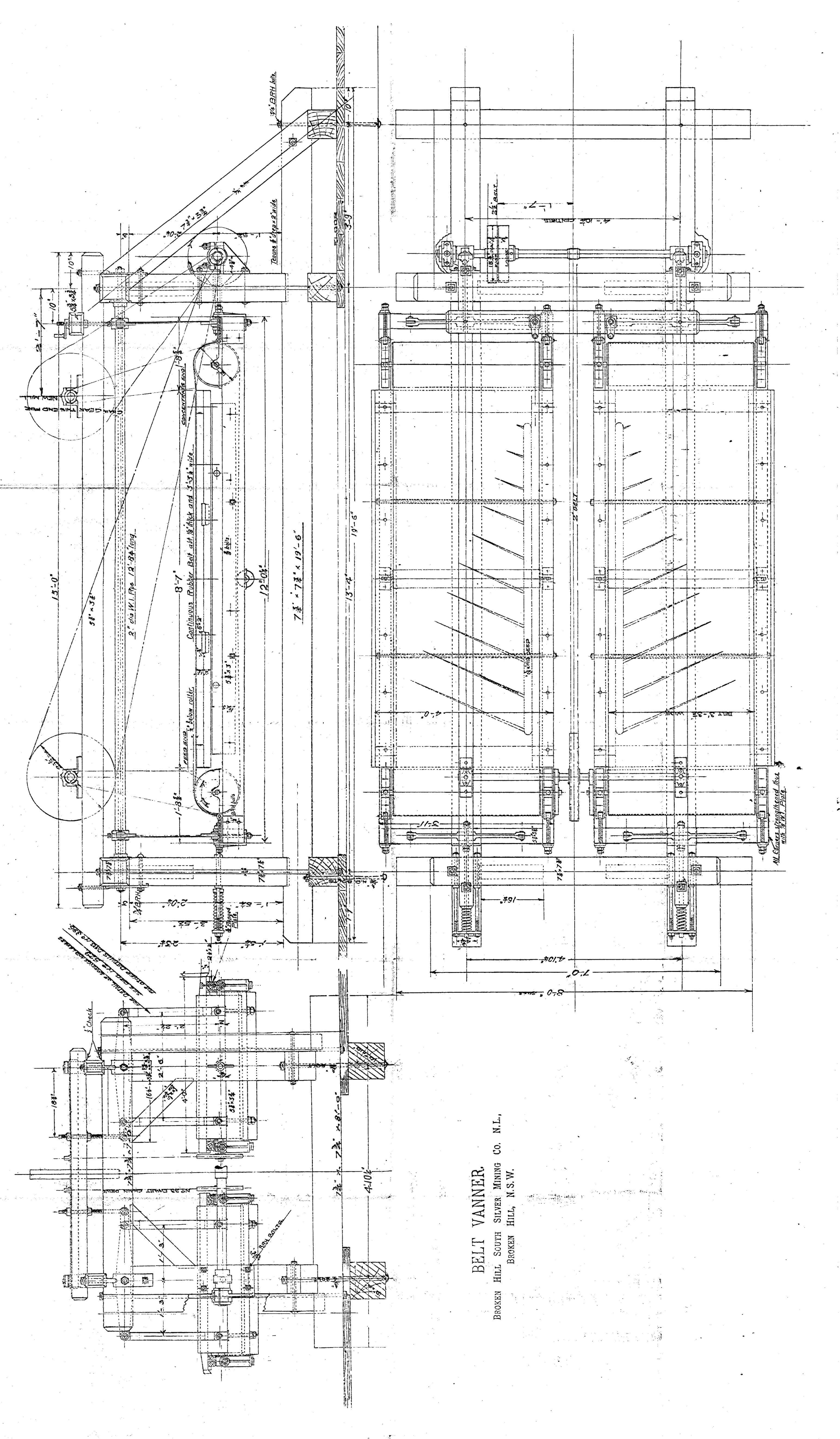The Frue Vanner is described in detail as being typical of the shaking travelling-belt concentrators. Machines of this class are especially adapted for treating finely-crushed battery sands which do not contain a large percentage of “mineral” (that is, sulphides and other heavy materials). They are frequently set to concentrate unsized pulp coming straight from the amalgamating tables.
The Frue vanner (Fig. 47) consists of an endless rubber belt, mounted on a frame, with its upper surface slightly inclined to the horizon, and subjected to two movements, a slow constant longitudinal movement and a slight and rapid side shake. The belt forms the bed or plane on which the dressing of the ore is effected, being an inclined plane, 12 feet long, and bounded down the two sides by projecting rubber flanges, which prevent the water and sand from dropping over the sides. An arrangement of rollers permits of the belt being slowly revolved in the direction of its length and up the incline; thus, though the dimensions of the working plane remain always the same, its surface is constantly travelling. The crushed rock in a stream of water is delivered near the upper end of the belt by means of the sand distributor, No. 1, Fig. 47, and flows down the belt towards its lower end. Now, as the inclination at which the belt is set is only from 3 to 6 inches on the 12 feet, and as the stream of water is not large and spreads over the whole width of 4 feet, it is obvious that, if it were not for the movements of the belt, much of the crushed rock contained in the water would settle on the belt, while the water and the liner and lighter particles of sand would alone reach the foot of the table and drop over into a waste launder.
In order to separate the heavy metallic minerals from the accompanying gangue or rock, a second stream of water is applied, whilst a gentle side shake is given to the belt, to keep the sand in a state of agitation, prevent it from “packing,” and facilitate the sorting process. The water distributor, 2, is placed about a foot above the pulp distributor, and delivers small jets of water, 3 inches apart, over the entire width of the belt. The side shake thoroughly mixes this water with the pulp, spreads the whole uniformly on the belt, and enables the heavy particles of mineral to settle through the sand and cling to the belt, when they are carried up by it past the small jets of water and deposited in the collecting tank, while the lighter gangue is carried down by the stream and delivered into the tailings launder.
The Frue vanner is shown in plan in Fig. 47a, in side elevation in Fig. 47b, and in end elevation in Fig. 47c. The following description is abridged from that given by the manufacturers:
A A are the main rollers that carry the belt and form the ends of the table, B and C being other rollers. The belt E, which is 4 feet wide and 27½ feet in entire length, passes through water underneath B, depositing its concentrations in the box, No. 4; and then passes over C, the tightening roller.
The cranks attached to the crank shaft, H, are ½ inch out of centre, thus giving a throw of 1 inch, which is the amount of the lateral throw. I is the driving pulley that forms with its belt the entire connection with the power. J is a cone pulley on the crank shaft, H. By shifting the small leather belt connecting J and W, the uphill travel of the main belt, E, is increased or diminished at will; the pulley, W, is moved by the hand-screw, m. R, R, R are three flat-steel spring connections bolted underneath the cross-pieces of the frame, F, and attached to the cranks of the shaft, H. These springs give the quick lateral motion—about 200 per minute.
No. 2 is the clear water distributor, and is a wooden trough which is supplied with water by a pipe, and the water discharges on the belt in drops through grooves 3 inches apart.
No. 1 is the ore-spreader, which moves with F, and delivers the ore and water evenly on the belt.
There is also a copper well that fits in (and shakes with) the ore-spreader as shown in the drawing. This is used in concentrating gold ores, for saving amalgam and quicksilver escaping from the silvered plates above, and can be taken out and emptied at any time. Into this well falls all the pulp from the battery. Its ends are lower than the wooden blocks of the spreader, so that the pulp passes over the ends of the well and is evenly distributed.
For some gold ores it is desirable to use on the ore-spreader a silvered copper plate the size of the spreader, and, when this is used, the wooden blocks of the spreader are fastened to a movable frame on top, so that they can be removed when the plate is cleaned-up, once or twice a month. No. 8 is a section of the launder to carry off the tailings.
The speed of the uphill travel of the belt varies from 2 to 12 feet per minute. If the ore treated be poor in pyrites, the upward motion of the belt does not exceed 20 inches per minute; if richer, the speed is increased accordingly, and in agreement with the inclination of the belt, being greater as this inclination increases, but usually not exceeding 3½ feet per minute. The inclination can be changed at will by wedges at the foot of the machine. The motion, the water used, the grade, and the uphill travel is regulated for every ore individually, and must be adjusted with every change in the pulp, if good work is to be maintained.
The amount of water used on the machine is from 1 to 1½ gallons per minute of clear water at the head, and from 1½ to 3 gallons per minute with the pulp.
The capacity per day of twenty-four hours is usually put down as about 6 tons of material, fine enough to pass a 40-mesh screen. In California, in general, two Frue vanners treat the product of each battery of five stamps. Where the gangue is light, only one Frue vanner is sometimes used for five stamps.
Sizing of the pulp is usually omitted if the material is fine enough to pass a 30- or 40-mesh screen. If particles coarser than this are present they are removed by classifiers.
A riffled belt is sometimes used on the Frue vanner in cases where large quantities of comparatively coarse sulphides are present.
In the Luhrig vanner the endless travelling india-rubber band is not flanged at the sides, and has a slight side inclination, which is, therefore, at right angles to the direction of travel; the latter is horizontal, not inclined ; by an arrangement of cams and springs, end-blows are given to the framework carrying the belt. The pulp from the batteries is collected in settling boxes placed overhead and delivered on to the belt through a small distributing box situated above its right-hand upper corner, the belt being driven from right to left. Clear water is supplied through a perforated pipe fixed diagonally across the belt. The pulp moves across the belt from the higher side to the lower, this motion being assisted by the clear water; the light particles of gangue are washed down in this direction at a faster rate than the heavy particles of pyrites. On the other hand, the travel of the belt and the end-blows move the ore in the direction of the length of the belt. The results of the combined motions are as follows :—
- Tailings pass off the table nearly opposite the distributing box at the right-hand end.
- A middle product, containing both sulphides and gangue, is delivered near the middle of the side of the belt.
- Clean concentrates are delivered near the left-hand end of the belt, having travelled the greatest distance before being washed off at the side.
Each of these three products is delivered into a separate hopper, and by a simple arrangement of sliding plates the exact points on the belt at which the delivery of the middle product is divided from those of the headings and tailings can be altered, so that the percentage of each product can be regulated.
The amount of ore treated in twenty-four hours by one of these machines is stated to be 4 to 5 tons if the concentrates are iron pyrites, and 3 to 4 tons if they are galena and blende.

